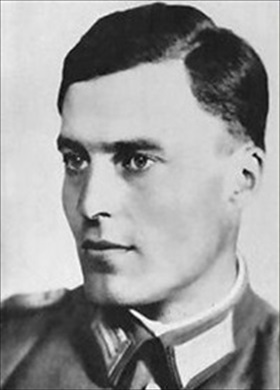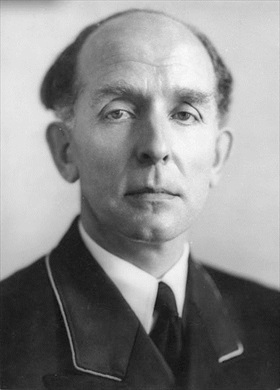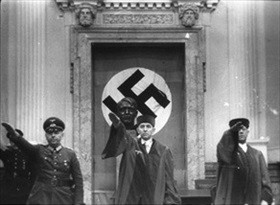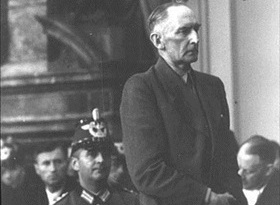FAILED HITLER ASSASSINS TO GET DAY IN COURT
Berlin, Germany • August 7, 1944
On July 20, 1944, Col. Claus von Stauffenberg left a bomb in his briefcase in a conference room at the East Prussia headquarters of Adolf Hitler, the Wolf’s Lair (Wolfsschanze), before excusing himself to take a call in the telephone exchange hut. In the conference room were Hitler and his senior officers, examining operations maps spread over an oaken table. It is thought that one of the participants, seeking leg room, moved the briefcase behind a massive support leg almost as wide as the map table itself. When the bomb exploded, the table leg deflected the blast from its intended victim. The detonation was the start of Operation Walkuere (Valkyrie), the codename of the officers’ coup. As did most people in the conference room, Hitler overcame the effects of the blast—singed hair and trousers, perforated eardrums, and injuries to an arm and leg—to thwart the coup and, in concert with Reichsfuerher-SS Heinrich Himmler’s Gestapo and the Nazis’ political courts, extracted a savage revenge in the final stages of the war in Europe
Beginning on this date, August 7, 1944, Nazi Judge-President Roland Freisler of Berlin’s People’s Court (Volksgerichtshof) opened a series of show trials against the conspirators rounded up in the dragnet. The trials were held in the swastika-bedecked Great Hall of the Berlin Chamber Court. Selected civil servants, party functionaries, military officers, and journalists were among the 300 or so in attendance. Behind Freisler on the dais was a film camera. Nazi Minister of Public Enlightenment and Propaganda Joseph Goebbels filmed the proceedings to strike terror in potential dissidents within Germany and to allow Hitler to view the proceedings in private. The defendants that day—two jurists and six army officers—were prevented from consulting with their lawyers and forced to stand before the court in shabby clothes. Freisler shouted down their attempts to address the court at any length and with a stridency that made it difficult for the film crew to record the defendants’ testimony so that their words could be heard by a film audience. All eight were condemned to death and hanged immediately. There was no possibility of appealing the verdict.
Four more show trials were held in August, and in every instance the accused was sentenced to death. Of the 7,000 alleged plotters—military and civilian—arrested by the Gestapo, nearly 5,000 were executed—among them two field marshals, 19 generals, 26 colonels, two ambassadors, seven diplomats, one cabinet minister, three secretaries of state, as well as the head of the Reich Police.
![]()
Operation Valkyrie and Defendants in Roland Freisler’s “People’s Court”
 |  |
Left: Claus von Stauffenberg (1907–1944) was a colonel in the Ersatzheer (Replacement Army) and the driving force behind the July 20, 1944, plot to assassinate Hitler and take control of Germany. For his involvement in the failed bomb plot known as Operation Valkyrie, he and several co-conspirators were shot by a firing squad in the Bendlerblock (headquarters of the Ersatzheer) in Berlin on the night of July 21, 1944, their bodies dumped in a shallow grave. A cinematic retelling of the officers’ plot to assassinate Hitler and replace his regime with a new German government was released in late 2008, starring the American actor Tom Cruise. Bendlerstrasse, the street on which army headquarters was located, has been renamed Stauffenbergstrasse.
![]()
Right: Roland Freisler (1893–1945). As then-Secretary of State for the Reich Ministry of Justice, Freisler attended the January 1942 Wannsee Conference at the Villa Minoux outside Berlin. Reinhard Heydrich, chief of the Reich Security Head (or Main) Office and head of the German secret police apparatus, had called the participants together as part of the Nazis’ quest to find a “final solution to the Jewish Question,” i.e., how to the murder Europe’s Jews. In August 1942 Freisler was appointed “President of the People’s Court” in the German capital.
 |  |
Left: Freisler (center) in the Great Hall of the Berlin Chamber Court, August 1944. Freisler’s kangaroo “People’s Court” had been set up to judge “political crimes” and was unequivocally an instrument of Nazi terror. Beginning in August 1944 Freisler presided over the trials of those charged in connection with the July 20 bomb plot to assassinate Hitler. Freisler was killed in his courtroom during an Allied air raid in February 1945 when he was hit on the head by falling masonry. Luise Jodl, wife of German Col. Gen. Alfred Jodl, Chief of the Operations Staff of the Armed Forces High Command, was working at Luetzow Hospital when Freisler’s body was brought in. “It is God’s verdict,” someone commented. As Luise Jodl recalled: “Not one person said a word in reply.”
![]()
Right: Sixty-two-year-old Field Marshal Erwin von Witzleben, shown in this photo from August 7, 1944, was the first to stand before Freisler, who immediately chastised him for returning a fleeting Nazi salute. Witzleben was further humiliated by being forced to hold his trousers at his waist, for he had been deprived of a belt or suspenders. Freisler shouted at one defendant struggling to keep his trousers on his hips: “You dirty old man. Why do you keep fiddling with your trousers?” Next to face Freisler was former Col. Gen. Erich Hoepner, commander of the Ersatzheer to which Stauffenberg belonged. Freisler addressed the defendant as “Schweinehund.” When Hoepner corrected Freisler, saying he was not a Schweinehund, Freisler asked him what zoological category he fitted into. During the 1947 Judges’ Trial, one of twelve U.S. trials collectively known as the “Subsequent Nuremberg Trials,” Goebbel’s films of the 1944 show trials were used against the highest-ranking officials of the Nazi judicial system. Freisler escaped indictment and punishment, having been killed in a 1945 bombing raid on Berlin. The Judges’ Trial was the inspiration for the 1961 Academy Awards-winning movie Judgment at Nuremberg.
History Channel Documentary on the Rise of Adolf Hitler and Operation Valkyrie—The Failed Officers’ Plot to Assassinate the German Leader (Multiple Episodes)
![]()

 History buffs, there is good news! The Daily Chronicles of World War II is now available as an ebook for $4.99 on Amazon.com. Containing a year’s worth of dated entries from this website, the ebook brings the story of this tumultuous era to life in a compelling, authoritative, and succinct manner. Featuring inventive navigation aids, the ebook enables readers to instantly move forward or backward by month and date to different dated entries. Simple and elegant! Click
History buffs, there is good news! The Daily Chronicles of World War II is now available as an ebook for $4.99 on Amazon.com. Containing a year’s worth of dated entries from this website, the ebook brings the story of this tumultuous era to life in a compelling, authoritative, and succinct manner. Featuring inventive navigation aids, the ebook enables readers to instantly move forward or backward by month and date to different dated entries. Simple and elegant! Click 











